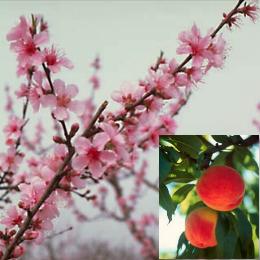
|
|
Peach
(Prunus persica)
|
Peach (Prunus persica)
The peach falls into the Prunoideae
subfamily of the Rosaceae. The subgenus Amygdalus contains the
commercially important peach and almond. In addition, there are four
other species closely related to peach: P. davidiana, P. kansuensis,
P. ferganensis, and P. mira. The former two species have small fruit
resembling peach, but poor eating quality and are used only as
rootstocks. P. ferganensis offers the best fruit quality of the
four, and is cultivated in the Fergana Valley region of the south
central (former) USSR, and in western China. P. mira is a shrub
form native to southern Tibet, Nepal, and northern India, where it is
infrequently cultivated for its fruit. Ornamental forms of peach are
used on a small scale as landscape trees. Fully doubled white flowers,
deep red flowers, dwarfism, and red-leaved traits have been expolited in
ornamental peaches. There is small interest in using flowering peach
shoots in floral arrangements because of their large, pink flowers borne
on long 1-year-old wood, but a method of producing these flowering
shoots more-or-less year round needs to be developed.
There are thousands of peach cultivars
worldwide, and far more are cultivated in economic quantities than for
apple or pear. WeI have separated peach cultivars into 3 groups as
follows:1. Nectarines - essentially fuzzless peaches; a single gene is responsible for the lack of fuzz.2. Freestone peaches - melting
flesh,
fresh market cultivars. 3. Clingstone peaches - firm flesh,
canning cultivars. The peach and nectarine trees
or shrubs grow upto 5 x 5 m. It is self pollinative and has an
impressive blossoming. Darwin (1731-1802) noticed
that peach trees spontaneously produced nectarines and that this
also happens the other way around. He even describes a tree that
produced a fruit that was half peach half nectarine and later fell
back producing peaches.
Peaches are from Chinese
origin. They go back to the 10th century B.C. and are often found
on illustrations from that time. The Chinese have developed an
incredible amount of peach of races. Peaches moved to Persia (Iran) along silk trading
routes.
The epithet persica denotes Persia, which is where Europeans
first obtained peaches. The peach got it's name
around 300 B.C. The greek philosopher Theophrastus thought it came
from Persia and named this lovely fruit to that country. In the
first century the fruit is mentioned by Romans who wrote that they
imported the fruit from Persia. It is supposed that the peach
reached Europe around the year 0. In England they don't show up
before 1650 A.D.
Strange enough, the nectarine
is never mentioned in descriptions from the time Before Christ. Peaches
moved to the new world with explorers of the 16th-17th centuries, with
Portuguese introducing it to S. America and Spaniards to N. America. Nectarines are first mentioned in America in 1720 when they grew
between the peach trees in Virginia. Today many types of
nectarines are cultivated.
Peach bark has been used as an herbal
remedy for a wide variety of ailments. It is said to be "one of the
stronger blood moving herbs", and therefore has use in encouraging
menstruation in females with delayed menses or congested blood. Essences of peach and plum are used to
flavor cigarettes in some countries.
As with most stone fruits, the peach was
a symbol of female genetalia in ancient China, a part of the Taoist
sexual mysticism. In fact, the Chinese word "tao" means peach. In Roman
mythology,
the peach was the fruit of Venus, and Albertus Magnus believed that
peaches were aphrodasiacs. On a less-sexual note, peaches were
associated with immortality and sincerity or truth. A peach with a leaf
attached symbolizes the union of the heart and tongue, hence truth. Peaches were used by ancient Egyptians
as offerings to the God of Tranquility.
Source:
http://www.uga.edu/fruit/peach.htm
http://www.thefruitpages.com/peaches.shtml
